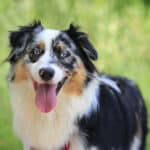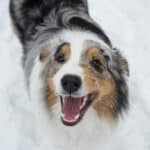With nearly 200 unique dog breeds to select from in the United States, you have your work cut out for you in narrowing down just one, but you’re trying. On your shortlist is the Australian Shepherd or Aussie. You love the look of this dog, but is the Aussie right for you?
Here are 9 reasons to adopt an Aussie:
- They’re popular
- Long lifespan (more than 10 years!)
- Big personalities
- Appealing coat colors
- Interesting eye and nose colors
- Easy maintenance
- Very intelligent
- Great watchdog
- Loves to please
Is your mind not quite made up? No problem! Ahead, we’ll talk more about each of the above reasons why Aussies are such loveable, wonderful dogs. By the time you’re done reading, you’ll know whether the Australian Shepherd is the dog for you.
9 Reasons to Adopt an Australian Shepherd

Very Popular
The American Kennel Club or AKC registers all purebred dog breeds, the Australian Shepherd among them. This club, formed in 1884, also ranks current breeds by popularity. According to the AKC’s website, the Aussie is number 17 out of 197 breeds.
Sure, the Aussie doesn’t crack the top 10, but 17 is still a pretty good rank! Aussies are more popular than 180 other dog breeds.
In 2018, the Aussie fared even better. , the AKC put the Australian Shepherd as number 15 out of 197. The Aussie beat out such esteemed breeds as the Great Dane, the Doberman Pinscher, the Shih-Tzu, the Boston Terrier, the Pomeranian, and the Pug.
Some dog owners mind very much about how on-trend their canine companions are while others couldn’t care less. The Aussie appeals to both parties. It’s relatively popular but not too popular that every second person you see at the dog park will have an Australian Shepherd. Yet Aussies aren’t so rare that most people haven’t heard of them.
Long Lifespan
When deciding which dog breed to add to your family, one of your top considerations is how long your new furry friend will live. You don’t want your dog to be taken away from you too soon, after all.
With Australian Shepherds, that should be less of a concern. The average lifespan of this breed is 12 to 15 years. This is impressive considering that 15 years is about the max longevity for dogs. That puts the Aussie right up there with long-living breeds such as the Shih-Tzu, the Maltese, the Lhasa Apso, and the Beagle.
To ensure your Aussie has many long, happy years with you ahead, you have to keep them healthy. Australian Shepherds are predisposed to certain health conditions such as cataracts, some cancers, epilepsy, and hip dysplasia.
Regular veterinary checkups are a must, including elbow and hip evaluations. If your vet suggests you take your Aussie to an ophthalmologist for an appointment, you should do that as well.

Big Personality
Do you want a dog with a vivid, booming personality? If so, look no further than the Aussie!
This is one lively dog. Attesting to their days as a herding breed, your Australian Shepherd will want to keep the family together, whether your family is more two-legged humans or four-legged fluffy friends like cats or other dogs.
The AKC calls the breed exuberant, and they’ve also been described as versatile. They’re very loyal to their owner, which we’ll talk about more a little later.
With great stamina, the Aussie can keep up with even the most rambunctious kids. Rather than blending in with other pets, don’t be surprised if your Australian Shepherd leads the pack!
Appealing Coat Colors
Single-colored the Australian Shepherd is not. Its coat comes in several appealing hues with markings that make the Aussie even more visually interesting. The most common coat colors are black and red, with the latter more of a ginger-brown color depending on the dog.
Some Aussies have dominant merle genes, which usually occur through very specialized breeding. We’ve written about merle Australian Shepherds before. If the merle gene is more dominant in this breed, then its coat can be either red or blue.
The red merle gene causes more red fur throughout the body compared to a regular red gene. Blue merle, in this case, isn’t bright blue like teal, but a grayish-blue. An Aussie with this coat color certainly stands out!
We must note that merle gene Australian Shepherds are not the norm, and thus, with their genetics, they normally have several health afflictions, blindness chief among them. If you want a merle gene Aussie, you must very carefully research breeders.
What about the markings on an Aussie’s coat? The markings are white or tan, sometimes a combination of both. A bicolor Aussie is one with a black, red, or blue head and body and a white or tan neck, chest, and paws. Tricolor Aussies might have tan and white paws in addition to the above markings.

Interesting Eye and Nose Colors
The range of eye colors in Australian Shepherds is not something you commonly see in other dog breeds.
Those colors include everything from blue to amber as well as green, dark and light brown, and even yellow. Some Aussies have eyes with flecks of another hue in the same color family.
What’s most interesting about the eye color of Australian Shepherds is this breed could have heterochromia. This means that each eye is its own unique hue.
While the nose color of an Aussie is usually dark brown or black, it again depends on genes. Red merle Aussies tend to have reddish noses to match. It’s the same with blue merle Aussies, although their noses are dark and look blackish rather than blue.
Easy Maintenance
We won’t sugarcoat it: the Australian Shepherd is a seasonal shedder. Its double coat will become more insulating in the winter and then thinner in the summer so the dog doesn’t overheat.
Although you might have to clean up a bit more dog hair than with lighter-shedding breeds, the other facets of maintaining the Aussie’s appearance are simple. Brush your Aussie about once per week with a slicker brush, which is a standard dog-grooming tool. During shedding time, increase your brushing frequency to about thrice weekly.
Brushing will spread the oils throughout your Australian Shepherd’s coat so it looks shiny, fresh, and healthy. You can also control shed fur through brushing as you catch the loose hair before it falls off your Aussie.
Besides brushing, trim the Aussie’s nails when they start to get long. Depending on how often you let your Australian Shepherd romp around in the mud, you might have to wash your dog semi-regularly or more rarely.

Very Intelligent
Here’s another great reason to adopt an Aussie: they’re whip-smart.
Due to its background as a herding breed, the Australian Shepherd’s intelligence can sometimes be downplayed, but not on this blog! We love to celebrate just how brainy the Aussie is. We think you’ll definitely be wowed by this breed’s intelligence.
Your Aussie will pick up on training easily as they quickly comprehend what you’re trying to teach them. Since they’ll master the basics so soon, you can then move on to tricks. You can even teach your Australian Shepherd more advanced tricks than some dogs are willing to learn such as play dead or how to fetch specific items.
Smart dogs like the Aussie still appreciate rewards when they learn commands and tasks. We recommend verbal and physical praise as well as treats, which will incentivize any dog.
You have to make sure you’re keeping your Aussie not only physically fit, but mentally fit as well. Australian Shepherds will get bored and thus destructive if there’s not enough stimulation in their life. Try throwing a treat puzzle toy at them and see how long it takes them to figure it out.

Great Watchdog
As we said we would, let’s talk more about the loyalty of the Australian Shepherd, as it’s another great part of this breed. The Aussie loves its family and will enter watchdog mode to keep a safe eye over you, your partner, and your kids.
Most herding breeds don’t easily trust strangers, and it’s the same case with the Australian Shepherd. Your dog might begin barking if someone you don’t know comes up to your doorstep. This can be a bit annoying if that person on your stoop happens to be the mailman or the pizza delivery person.
However, if there’s ever a stranger on the premises, you’ll be glad for your Aussie!
We do want to take a moment to differentiate between a watchdog and a guard dog, the latter of which the Aussie is not. Watchdogs will guard your home and bark to alert you of trouble. Should that trouble come barreling through the front door, a watchdog like the Aussie might attack if it felt like it had to defend itself.
However, its first inclination is not going to be violence. For that, you’d need a guard dog. Not only do guard dogs indicate to you when there’s a possible threat, but they will attack intruders. Some examples of guard dog breeds are German Shepherds, Rottweilers, and Dobermans.
Lots of people don’t want a violent dog, and you may be among them. That the Aussie is just a watchdog and not a guard dog isn’t such a bad thing.
Loves to Please
Are you still debating about whether to get an Aussie? We have one more reason why the Australian Shepherd is the right dog for you. This breed loves to make its favorite people happy.
When you train your Aussie, it will want to learn commands not only for its own benefit, but so you’re pleased with its performance. Aussies will listen to commands when issued for the same reason. They’ll play with the kids, lie at your feet (or on the couch if they’re allowed up there), and provide unmatched companionship!

Conclusion
The Australian Shepherd is a loving, affable breed. This mid-sized herding dog is very loyal so they’ll watch over you and your family. Aussies also boast great intelligence. They can also live for upwards of 15 years as well.
It’s for these reasons and the many others we covered in this article that an Aussie is such a fantastic dog!

